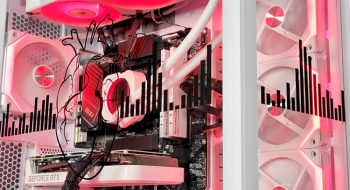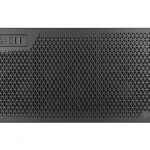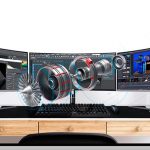What is Octane Render?
Octane Render is a real-time, physically correct 3D rendering engine created by OTOY. Recognized for its unique use of GPUs instead of the CPU. It leverages the power of the GPU to deliver impressive speed and quality. This state-of-the-art ray tracing engine is widely adopted in industries like film production, architectural visualization, and product design due to its ability to produce photorealistic images and animations quickly and efficiently. To build an Octane Render PC, continue reading below for more details on which components will best work for this software.
What is the recommended specification for an Octane Render PC?
Octane Render is primarily a GPU-driven application that can use multiple GPUs; however, isn’t strictly necessary. A 32 GB or greater system memory should be paired with a middle-tier performance CPU such as an i7 or R7. Storage demands aren’t exceptionally high, so that depends on personal preference. Keep the below specs in mind when building an Octane Render PC.
| CPU | I7/r7 series processor |
| GPU | 1-2 RTX 4080 or 4090 |
| Memory | 32-96gfb |
| Storage | 1tb OS drive with 2tb or greater working drive |
Does CPU play a role in Octane Render?
In Octane Render’s framework, the CPU isn’t directly responsible for rendering, but it plays a critical role in preparatory calculations for rendering and between frames in animations. Hence, a CPU with a high clock speed, like the AMD Ryzen 7700x or Intel 13700k, can significantly improve scene loading speed leveraging their class leading single core performance. It accomplishes this at a much lower cost than their 7950x and 13900k counterparts.
How powerful of a GPU is needed for Octane Render?
The GPU is the powerhouse behind Octane Render’s operation. Two key factors dictate the render capabilities: the GPU’s raw speed and the amount of memory on the card, or VRAM. GPUs like the GeForce RTX 4080 or GeForce RTX 4090 excel in both areas, providing plenty of VRAM and core performance. Octane Render scales excellently with multiple cards, implying that using multiple GPUs will proportionally improve render times. It’s important to note that they don’t need to be in SLI mode, though this feature is primarily discontinued anyway.
How much system memory (RAM) should my PC have for Octane Render?
The exact amount of RAM required largely depends on your individual projects. However, a minimum of 32GB RAM is a must for Octane Render, but we recommend 64 GB or more. If you’re also operating 3D modeling programs like Cinema 4D, Maya, or 3DS Max, you must account for the additional memory these applications need. The complexity of your scene can significantly impact the required system memory.
How much storage will I need for Octane Render files?
Solid-state drives (SSDs), especially newer NVMe-type SSDs with faster transfer rates, are strongly recommended for your OS and Octane Render due to their superior speed to traditional hard drives. A secondary SSD storing active projects can decrease load and save time, facilitating a smoother and more efficient rendering workflow. Traditional hard drives or external drive arrays offer a more economical long-term storage and backup alternative. In conclusion, to optimize your PC for Octane Render, prioritizing a robust GPU, a fast CPU prioritizing single-core performance over the number of cores, sufficient RAM, and swift SSD storage is essential. It can be found in our purpose-built workstation section if you’d like to get started with a configuration.









No comments yet